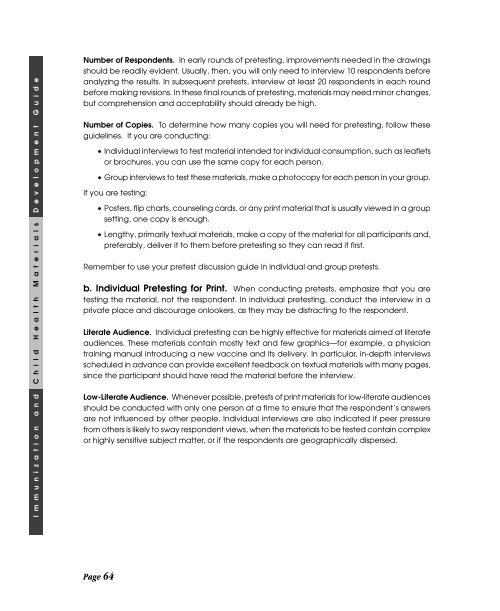Immunization and child health materials development guide pdf
Immunization and child health materials development guide pdf
Immunization and child health materials development guide pdf
You also want an ePaper? Increase the reach of your titles
YUMPU automatically turns print PDFs into web optimized ePapers that Google loves.
Number of Respondents. In early rounds of pretesting, improvements needed in the drawings<br />
should be readily evident. Usually, then, you will only need to interview 10 respondents before<br />
analyzing the results. In subsequent pretests, interview at least 20 respondents in each round<br />
before making revisions. In these final rounds of pretesting, <strong>materials</strong> may need minor changes,<br />
but comprehension <strong>and</strong> acceptability should already be high.<br />
Number of Copies. To determine how many copies you will need for pretesting, follow these<br />
<strong>guide</strong>lines. If you are conducting:<br />
• Individual interviews to test material intended for individual consumption, such as leaflets<br />
or brochures, you can use the same copy for each person.<br />
• Group interviews to test these <strong>materials</strong>, make a photocopy for each person in your group.<br />
If you are testing:<br />
• Posters, flip charts, counseling cards, or any print material that is usually viewed in a group<br />
setting, one copy is enough.<br />
• Lengthy, primarily textual <strong>materials</strong>, make a copy of the material for all participants <strong>and</strong>,<br />
preferably, deliver it to them before pretesting so they can read it first.<br />
Remember to use your pretest discussion <strong>guide</strong> in individual <strong>and</strong> group pretests.<br />
b. Individual Pretesting for Print. When conducting pretests, emphasize that you are<br />
testing the material, not the respondent. In individual pretesting, conduct the interview in a<br />
private place <strong>and</strong> discourage onlookers, as they may be distracting to the respondent.<br />
Literate Audience. Individual pretesting can be highly effective for <strong>materials</strong> aimed at literate<br />
audiences. These <strong>materials</strong> contain mostly text <strong>and</strong> few graphics—for example, a physician<br />
training manual introducing a new vaccine <strong>and</strong> its delivery. In particular, in-depth interviews<br />
scheduled in advance can provide excellent feedback on textual <strong>materials</strong> with many pages,<br />
since the participant should have read the material before the interview.<br />
Low-Literate Audience. Whenever possible, pretests of print <strong>materials</strong> for low-literate audiences<br />
should be conducted with only one person at a time to ensure that the respondent’s answers<br />
are not influenced by other people. Individual interviews are also indicated if peer pressure<br />
from others is likely to sway respondent views, when the <strong>materials</strong> to be tested contain complex<br />
or highly sensitive subject matter, or if the respondents are geographically dispersed.<br />
Page 64

















